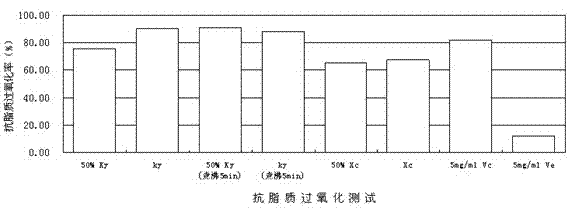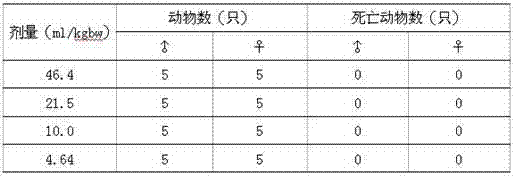Production method of microorganic antioxidant for foods
A food antioxidant and production method technology, applied in food preservation, food science, application, etc., can solve the problems of less antioxidants, high cost, and cumbersome methods and processes, and achieve strong antioxidant capacity, high safety, and promote cell growth. metabolic effect
- Summary
- Abstract
- Description
- Claims
- Application Information
AI Technical Summary
Problems solved by technology
Method used
Image
Examples
Embodiment 1
[0026] (1) Inoculate Rhodopseudomonas palustris into the lysing broth medium at a weight ratio of 2:100, culture anaerobically at 25°C for 50 hours, and store at 2°C for later use; inoculate Hansenula vinitis at a weight ratio 2:100 inoculated into the lysing broth medium, cultured anaerobically at 25°C for 50 hours, and stored at 2°C for use; Anaerobic culture for 50 hours, stored at 2°C for later use;
[0027] (2) Inoculate Rhodopseudomonas palustris, Hansenula vinitis, and Lactobacillus bulgaricus obtained in step (1) into the lysing broth medium at a weight ratio of 0.5:100, 1.5:100, and 1.0:100, respectively , respectively cultured anaerobically at 30°C for 12 hours in shake flasks;
[0028] (3) Sterilize the fermentation tank with steam at a temperature of 120°C and a pressure of 0.152Mpa for 35 minutes, add the fermentation base material, and pasteurize it at 70°C for 20 minutes. The fermentation base material is composed of the following raw materials in weight percen...
Embodiment 2
[0032] (1) Inoculate Rhodopseudomonas palustris into the lysis broth medium at a weight ratio of 4:100, culture anaerobically at 30°C for 40 hours, and store at 2°C for later use; inoculate Hansenula vinitis at a weight ratio 4:100 was inoculated into the lysing broth medium, anaerobically cultured at 30°C for 40 hours, and stored at 2°C for later use; Oxygen culture for 40 hours, stored at 4°C for later use;
[0033] (2) Inoculate Rhodopseudomonas palustris, Hansenula vinitis, and Lactobacillus bulgaricus obtained in step (1) into the lysing broth medium at a weight ratio of 1:100, 2.0:100, and 1.5:100, respectively , respectively cultured anaerobically at 35°C for 10 hours in shake flasks;
[0034] (3) Sterilize the fermenter with steam at a temperature of 121°C and a pressure of 0.148Mpa for 30 minutes, add the fermentation base material, and pasteurize it at 75°C for 15 minutes. The fermentation base material is composed of the following raw materials in weight percentage...
Embodiment 3
[0038](1) Inoculate Rhodopseudomonas palustris into the lysing broth medium at a weight ratio of 3:100, culture anaerobically at 35°C for 30 hours, and store at 6°C for use; inoculate Hansenula vinitis at a weight ratio of 3:100 was inoculated into the lysing broth medium, anaerobically cultured at 35°C for 30 hours, and stored at 6°C for later use; Oxygen culture for 30 hours, stored at 6°C for later use;
[0039] (2) Inoculate Rhodopseudomonas palustris, Hansenula vinitis, and Lactobacillus bulgaricus obtained in step (1) into the lysing broth medium at a weight ratio of 1.5:100, 2.5:100, and 2.0:100, respectively , respectively cultured anaerobically at 40°C for 8 hours in shake flasks;
[0040] (3) Sterilize the fermenter with steam at a temperature of 125°C and a pressure of 0.142Mpa for 20 minutes, add the fermentation base material, and pasteurize it at 80°C for 10 minutes. The fermentation base material is composed of the following raw materials in weight percentage: ...
PUM
 Login to View More
Login to View More Abstract
Description
Claims
Application Information
 Login to View More
Login to View More - Generate Ideas
- Intellectual Property
- Life Sciences
- Materials
- Tech Scout
- Unparalleled Data Quality
- Higher Quality Content
- 60% Fewer Hallucinations
Browse by: Latest US Patents, China's latest patents, Technical Efficacy Thesaurus, Application Domain, Technology Topic, Popular Technical Reports.
© 2025 PatSnap. All rights reserved.Legal|Privacy policy|Modern Slavery Act Transparency Statement|Sitemap|About US| Contact US: help@patsnap.com


